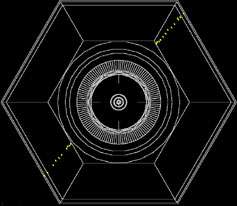Particles from Space Test New Muon Detection System

The newly installed muon identification system in the BaBar detector is working beautifully. Taking advantage of naturally occurring cosmic rays, the BaBar team has been testing the new detection system in preparation for the January start-up.
Earthly cosmic rays come mostly from protons in outer space. When the protons hit the air in our upper atmosphere, the interactions produce a shower of particles, many of which decay to muons that live long enough to reach the Earth's surface and the BaBar detector.
As the image at right shows, the new Limited Streamer Tubes (LSTs) are tracking muons in the outer, hexagonal-shaped layer of the detector. LSTs replaced the original muon system in two of the hexagon's six sextants in 2004. Crews upgraded the remaining four sextants during the current shut-down.
"The straightness of the measured muon track and the lack of missing hits along it indicate that the detectors are working well and have been connected properly," said LST co-commissioner Mark Convery. Co-commissioner Gianluigi Cibinetto notes that the lack of spurious hits in the detector promises a clean identification environment for muons for the rest of the experiment.
See more images here.
Source: by Heather Rock Woods, SLAC




















